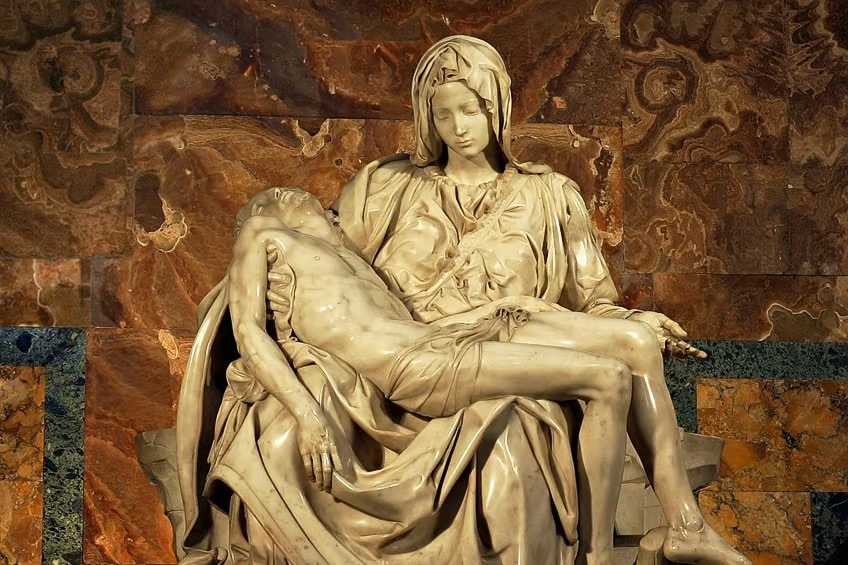Famous Sculptures – Discover History’s Most Famous Art Statues
Sculpture is an art form that can be appreciated from many angles and styles. Sculpture is complementary to many aspects of life, including architecture, interior, and exterior decor, engineering, and design. This article will outline the top 15 most famous sculptures in the world, including some of Michelangelo’s famous works and some of art history’s most famous sculptors.
Contents
- 1 Top 15 Most Famous Sculptures to Date
- 1.1 Venus of Willendorf (c. 25 – 30 kya BC)
- 1.2 Venus de Milo (c. 150 – 125 BC) by Alexandros of Antioch
- 1.3 Bust of Nefertiti (1345 BCE) by Thutmose
- 1.4 David (1430 – 1440) by Donatello
- 1.5 Pietà (1498 – 1499) by Michelangelo
- 1.6 The Golden Buddha (c. 13 – 14th Century) of Bangkok
- 1.7 David (1501 – 1504) by Michelangelo
- 1.8 Le Penseur (1904) by Auguste Rodin
- 1.9 Guitar (1914) by Pablo Picasso
- 1.10 Abraham Lincoln (1920) by Daniel Chester French
- 1.11 Calder’s Circus (1926 – 1931) by Alexander Calder
- 1.12 Spiral Jetty (1970) by Robert Smithson
- 1.13 Balloon Dog (1994 – 2000) by Jeff Koons
- 1.14 Maman (1999) by Louise Bourgeois
- 1.15 Cloud Gate (2006) by Anish Kapoor
- 2 The World’s Most Famous Sculptors
- 3 Sculpture: A Site of Transformation and Meaning
- 4 Frequently Asked Questions
Top 15 Most Famous Sculptures to Date
Sculpture is a visual art form that is defined as operating in three dimensions and is characterized by the presence of height, width, and depth. Sculpture is derived from an art form known as the plastic arts, which involved the activities associated with molding, ceramic-making, and the manipulation of plastic. Early sculpture processes included carving, which involved the removal of material from another object or fixed surface, and modeling, which involved the addition of material.
Early mediums for sculpture included clay, wood, stone, and metals such as iron and bronze. Today, sculptural art can be ideated and realized in many different forms.
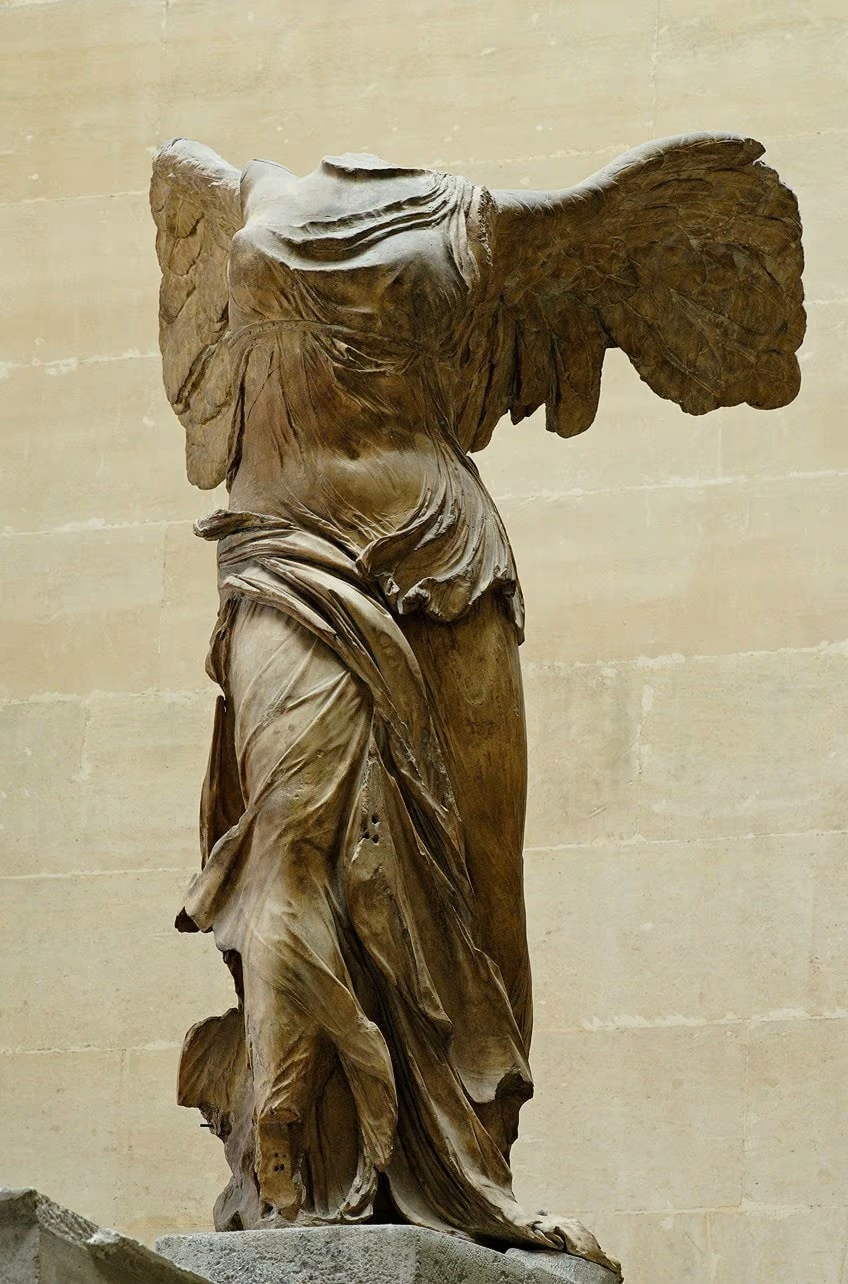
Whether it is executed through welding, carving, or casting, sculpture is one of the most dynamic art forms that also allow for durability and longevity in an artwork. Outside of Western art history, many sculptural elements had been found across Asia and Africa, including certain cultures of the Mediterranean that used sculpture as a visual expression for religious and political purposes.
Western examples of sculpture can be found in the ancient antiquity regions of Greece, Rome, and other regions conquered by these civilizations.
Popular representations in famous sculptural artworks include subjects from Christian narratives, deities from Greco-Roman mythology, religious iconography, animals, therianthropic figures, the human body, and smaller works that once served superstitious or decorative value. Below, we will delve into the top 15 most famous sculptures in art history.
Venus of Willendorf (c. 25 – 30 kya BC)
| Artist Name | Artist unknown |
| Date | c. 25 – 30 kya BC |
| Medium | Oolitic limestone |
| Dimensions (cm) | 11.1 |
| Where It Is Housed | Naturhistorisches Museum, Vienna, Austria |
One of the oldest and most famous sculptures in the world is the tiny figure of the Venus of Willendorf, which was unearthed in 1908 in the Paleolithic archaeological site in lower Austria. Carved from a sedimentary rock referred to as oölite, this small-scale wonder was found tinted with a red ochre pigment and is said to have been a self-portrait executed by a woman due to the proportions represented in the figure.
Alongside this Venus figurine were other figurines that displayed the same characteristics as this Venus figure.

The characteristics of the Venus figures include a nude (or Venus) figure with exaggerated body features on the curvature, breasts, and the absence of feet. It is said that these figures probably served as a deity for fertility and childbearing. This Venus is seen with no clear facial features but rather a few rows of bands around the head, which possibly represents a headdress.
Since there was no evidence relating to the process of production, there is also no way of determining who the artist was or if there were any feet on the sculpture at any point.
Venus de Milo (c. 150 – 125 BC) by Alexandros of Antioch
| Artist Name | Alexandros of Antioch (2nd – 1st century BCE) |
| Date | c. 150 – 125 BC |
| Medium | Parian Marble |
| Dimensions (cm) | 204 |
| Where It Is Housed | Louvre, Paris |
Famous enough to be included at the Louvre in Paris, Venus de Milo is also one of the most recognized sculptures in art history, easily identified by the figure’s missing arms. This massive two-meter statue was sculpted by Alexandros of Antioch during the Hellenistic period of Ancient Greece. The statue gained its name from the site of its discovery on the Greek island of Milos in 1820. Venus refers to the Greek equivalent of Aphrodite, who was a goddess of love and fertility and is also known as the Aphrodite de Milos.
The figure in question has also been a topic of debate since a few scholars suggested that the figure may also be Amphitrite who is the sea goddess that was venerated on the island of Milos.
Aphrodite is depicted partially naked with her robe falling off the bottom half of her torso. It is said that the statue originally came with a plinth and was created with both earlobes intact, two feet, and arms intact. The statue of Aphrodite was also at one point under threat from the German invasions that targeted art institutions in France during World War II.
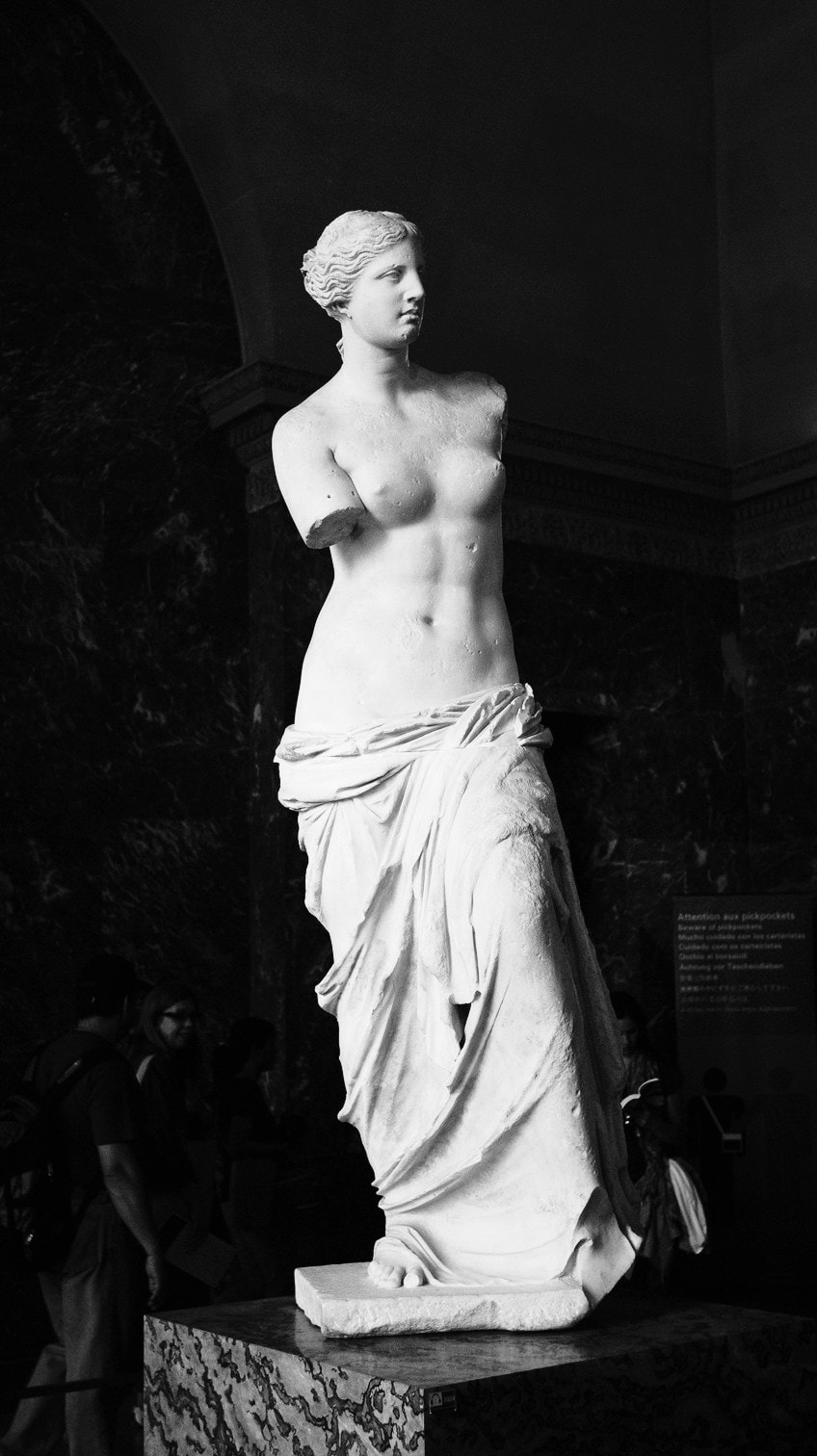
Luckily, upon request by the director of the French Musées Nationaux, the sculpture was sent to safety at the Château de Valençay. Venus de Milo also made her appearance in the works of the Spanish Surrealist Salvador Dalí in 1936 and 1969.
Alongside its influence in the art world, Venus de Milo also made its way into multiple popular culture pieces, including the 1997 Disney film, Hercules, comedy sketches, and a 1966 spoof movie The Last of the Secret Agents.
Bust of Nefertiti (1345 BCE) by Thutmose
| Artist Name | Thutmose (also known as the master of works and the King’s favorite sculptor; b. 14th century BCE) |
| Date | c. 1345 BCE |
| Medium | Limestone and stucco |
| Dimensions (cm) | 48 (h) |
| Where It Is Housed | Neues Museum Berlin, Germany |
Discovered by Ludwig Borchardt in 1912 in Egypt, this image of Nefertiti is one of the most famous images of Egyptian sculpture. The Nefertiti bust portrays the royal wife of Pharaoh Akhenaten executed by one of the best sculptors in Egyptian history, Thutmose, in 1345 BCE. The bust was found in the great sculptor’s workshop and has since traveled the world since its discovery. The bust now serves as a must-see cultural symbolism of Berlin and Egypt.
The bust, upon inspection, is reported to have no signs of inscriptions but was identified to be Nefertiti herself from the style of her crown.
Weighing approximately 20 kilograms, the bust is a symmetrical work of art that is in great condition, however, the left eye is missing the inlay that can be seen on the right eye. What makes this bust so amazing is that it is a reflection of the classical Egyptian style of the time, which was an outlier from other styles such as the Amarna art style seen during Akhenaten’s regime. Since the bust was found in the sculptor’s workshop, it can be said that the artwork was probably a reference artwork used for painting portraits.
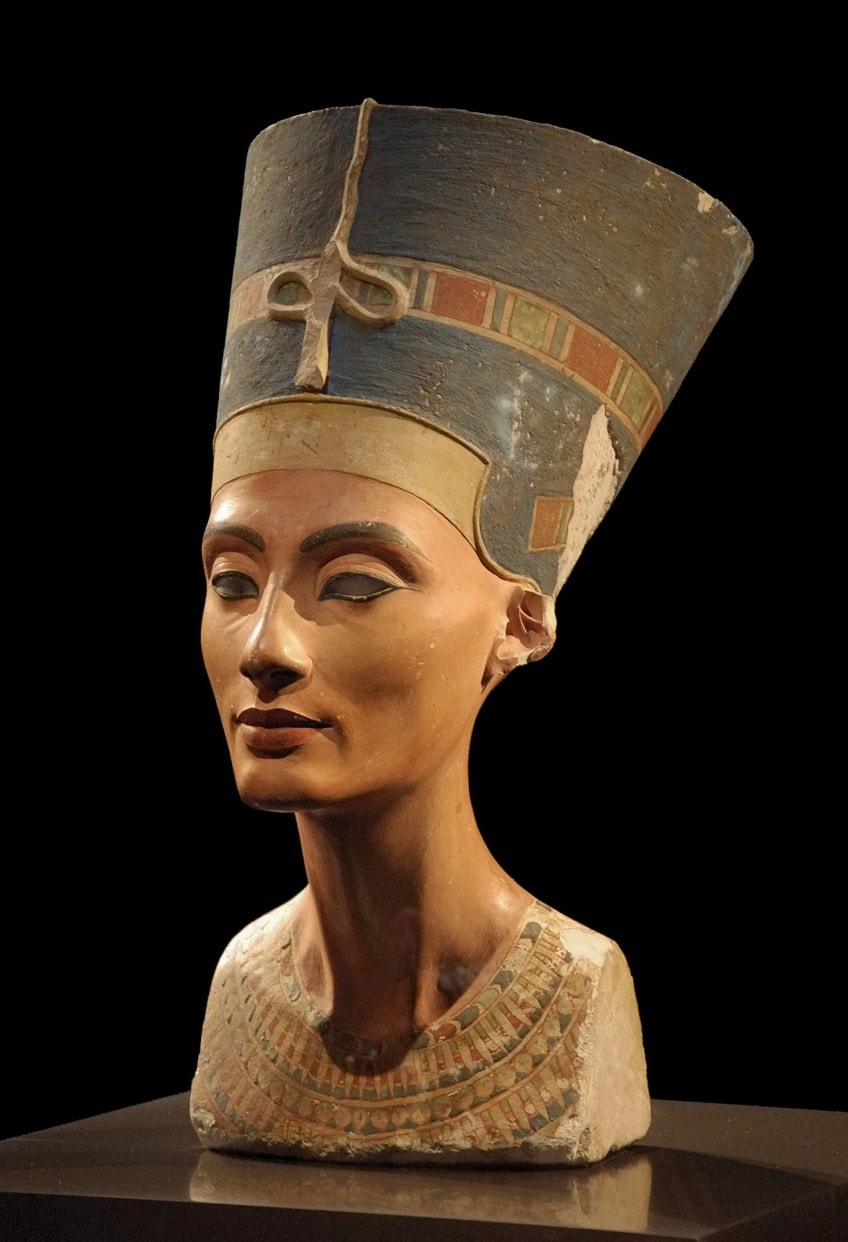
Although time has been somewhat detrimental to the sculpture, this bust features six colors; blue, light red, yellow, white, black, and green. Another interesting fact about the analysis of the Bust of Nefertiti is that during its second computed tomography scan (CT scan), it was found that a wrinkled version of the subject’s face was carved on the inside, alluding to the fact that the sculptor used different layers of thickness on the limestone center.
The “second face” of Nefertiti revealed more creasing around her mouth, and cheeks, as well as a swollen nose. Perhaps this may have been an indication of the artist attempting to cater to the ideals of sculpture when depicting royal subjects.
David (1430 – 1440) by Donatello
| Artist Name | Donato di Niccolò di Betto Bardi (1386 – 1466) |
| Date | 1430 – 1440 |
| Medium | Bronze |
| Dimensions (cm) | 158 |
| Where It Is Housed | Palazzo del Bargello, Florence, Italy |
The bronze David is one of Donatello’s (and the world’s) most famous statues. This statue depicts the nude biblical character, David, only “clothed” with a pair of boots. This caused quite the debacle back in the day since David was a biblical hero and this depiction was considered almost “disrespectful”.
Some critics suggested that the nude David was a reflection of the “homoerotic qualities” of the artist himself, thus placing judgment on the masterpiece based on Donatello’s sexual orientation.
Donatello also made another David sculpture, executed in marble but the bronze David is considered to be the first significant work of the Renaissance. The sculpture was also commissioned by one of the most problematic families in Italy, the Medicis. The bronze David by Donatello is also a key artwork for recognition of the queer or artwork made for the queer gaze. While not only serving as the first free-standing, nude bronze male statue, David is also a reflection of Florence during the time.

Florence was a small city-state, which was also known for its acceptance of queer artists during a time when the rest of the art world was averse to the idea of homosexuality. The narrative of David and Goliath was also a popular motif in the region and we can therefore also include the bronze David sculpture in the repertoire of important works by queer artists like Donatello. If one takes a closer look at the sculpture, one will find that David is entirely nude except for his sandals, shin guards, and helmet adorning his smooth and androgynous body.
Unlike other sculptures of David, this one is not muscular and does not carry the classic heroic pose. This is, therefore, not an idealized version of David, instead, one might say that it is a sexualized and desired David.
In the sculpture, David is also seen resting his hand on his hip, which protrudes provocatively while he lays his foot on the head of the Philistine conqueror. If examined from the back, it becomes almost impossible to determine the sex or gender of the subject and is perhaps an intentional feature, given the lack of traditional displays of masculinity, as found in other Renaissance works.
David’s hair is sculpted as long and contains traces of gold, indicating that his hair was once gilded in full gold. It is also said that this bronze David is a representation of the union between humanist and classical concepts in connection with Christian iconography. The narrative of David and Goliath presents the humanist ideal that will overpower strength alongside the Christian belief that with faith in God, one can conquer any obstacle.
This is highlighted by the fact that David is presented as a non-muscular youth facing an enemy who is 100 times stronger.
Art historians have discovered that the face of David was modeled after the bust of Antinous, who was Emperor Hadrian’s partner. The bronze David sculpture is therefore denotative of ancient ideals within the Renaissance such as the value of the virtue of physical perfection (beauty) and a celebration of sexual relationships between attractive young men and older men.
Pietà (1498 – 1499) by Michelangelo
| Artist Name | Michelangelo di Lodovico Buonarroti Simoni (1475 – 1564) |
| Date | 1498 – 1499 |
| Medium | Carrara marble |
| Dimensions (cm) | 174 x 195 |
| Where It Is Housed | St. Peter’s Basilica, Vatican City |
One of Michelangelo’s famous works is an art statue, Pietà, executed between 1498 and 1499 is an iconic sculpture depicting the two most important biblical characters, Jesus and Mary. To depict “the heart’s image”, Michelangelo created a pyramidal structure, which begins at the top with Mary’s head and gradually widens with Jesus’ body, Mary’s garments, and the rock of Golgotha.
The iconic image represents Mary cradling Jesus’ body after his crucifixion. Mary, also called the Madonna, is depicted as youthful and is said to symbolize her purity and innocence.
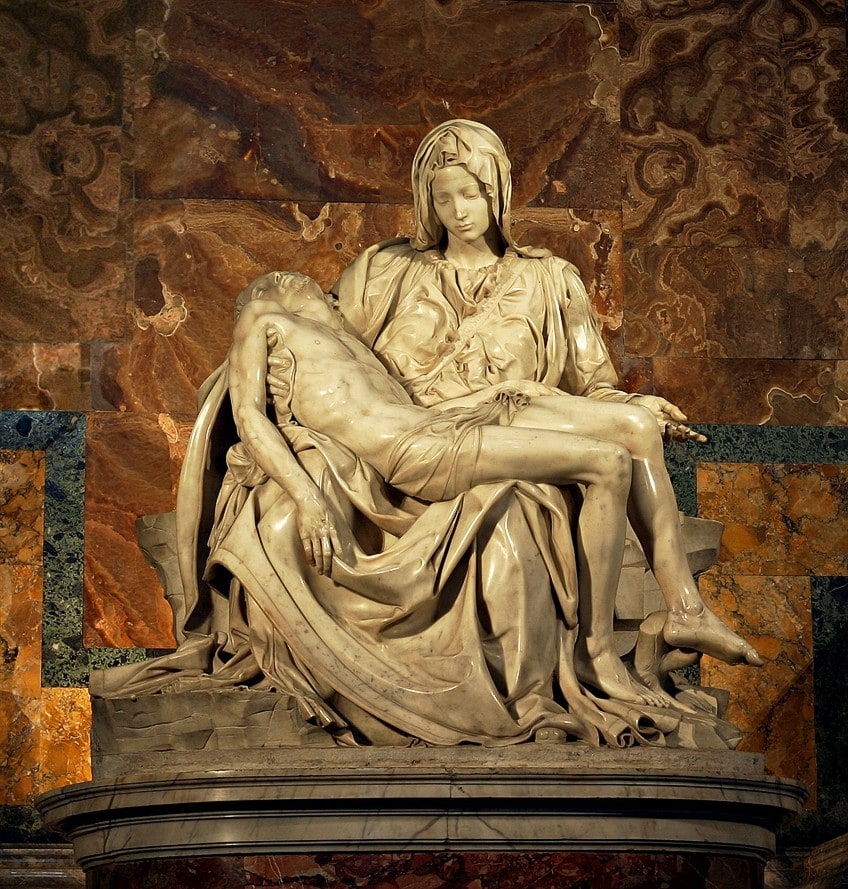
While you may assume that Michelangelo created this piece with a tremendous amount of perfection in mind, it appears that the sculpture is very much out of proportion, which is understandable considering the task of depicting an adult male in the arms of a woman’s lap.
Michelangelo also chose to represent the scene in a different manner than often portrayed.
While others represented Mary as much older, Michelangelo chose to represent her youth and move the scene away from its associations with death. Michelangelo chose to instead represent abandonment through the face of Jesus and the communion of God and mankind through Christ.
The Golden Buddha (c. 13 – 14th Century) of Bangkok
| Date | c. 13 – 14th century |
| Period | Sukhothai Dynasty |
| Medium | Gold |
| Dimensions (m) | 3 |
| Where It Is Housed | Wat Traimit, Samphanthawong, Bangkok, Thailand |
The solid three-meter-high golden statue of the Buddha is known as one of the most famous historical sculptures in Asia and can be found at the temple of Wat Traimit in Thailand. This historical wonder is believed to have once been enclosed in a layer of glass and stucco to conceal its true value, which is estimated to be worth over $250 million. Created by an unknown sculptor during the Sukhothai Dynasty, not much is known about the origins of this sacred sculpture.
During one of the sculpture’s many relocations, in 1995, the sculpture fell to the ground and chipped. As you can imagine, the revelation of the sculpture being solid gold came as a surprise to many.

The statue was also regarded as a miracle since its discovery as “gold” fell along the same timeline as the commemoration of the 25th year since Gautama Buddha’s passing. The statue is seen in the traditional pose of Bhumisparsha Mudra, which is characterized by the figure appearing to “touch the earth with the right hand that also bears witness to Lord Buddha’s enlightenment and victory over Mara”.
David (1501 – 1504) by Michelangelo
| Date | 1501 – 1504 |
| Medium | Marble |
| Dimensions (cm) | 517 x 199 |
| Where It Is Housed | Galleria dell’Accademia, Florence, Italy |
Nearly 100 years later, Michelangelo arrived on the scene to take his pick at depicting the popular biblical character, David. David is one of the world’s most famous statues executed when Michelangelo was only 26 years of age upon commission.
Through his expert use of attention to detail and mastery over the chisel, he sculpted David out of the marble in the contrapposto pose.

The details on this famous statue’s hand are remarkably life-like and show the bravery and focus of the character, as illustrated by his bulging veins. Some other examples of Michelangelo’s famous works include Crucifix (1492), Angel (1495), Madonna of Bruges (1504), and The Deposition (1547).
Le Penseur (1904) by Auguste Rodin
| Artist Name | François Auguste René Rodin (1840 – 1917) |
| Date | 1904 |
| Medium | Bronze |
| Dimensions (cm) | 71.5 x 36.4 x 59.5 |
| Where It Is Housed | Musée Rodin, Paris, France |
Whether you are an art lover or not, you have certainly heard of one of the most famous art statues, “the thinker”, which is a sculpture made by famous French artist, Auguste Rodin, originally in 1880 and in another work for Dante Alighieri’s poem, Inferno from The Divine Comedy (1308 – 1321). Here, the thinker was first called “the poet” and was depicted as nude at the entrance of The Gates of Hell (1880), positioned in a pensive manner.
The Thinker eventually received an upgrade to bronze in the early 1900s, after being renamed by Rodin in 1888.

The Thinker was first exhibited in 1904 at the annual Salon and received a great deal of attention, more so than the original smaller version on The Gates of Hell. A public petition ensued and the French government eventually purchased the work for installation in the Panthéon around 1906 as part of a gift for the city of Paris. Thereafter, the sculpture was relocated to the Musée Rodin in 1922.
Rodin was not selfish in distributing his vision for the sculpture and was loved by all.
The sculpture was thereafter reproduced with many other copies being mounted across the world. Other sites where you can find copies of The Thinker include Cleveland, San Francisco, Philadelphia, Moscow, Tokyo, and Buenos Aires.
Guitar (1914) by Pablo Picasso
| Artist Name | Pablo Ruiz Picasso (1881 – 1973) |
| Date | 1914 |
| Medium | Ferrous sheet metal and wire |
| Dimensions (cm) | 77.5 x 35 x 19.3 |
| Where It Is Housed | The Museum of Modern Art, New York City, New York |
Guitar (1914) by Spanish world icon and artist, Pablo Picasso is one of the most famous sculptures in the world for its position as one of the earliest surviving sculptures from the Cubist art movement. According to Picasso’s art dealer, D. H. Kahnweiler, the sculpture was inspired by an African Grebo mask where the eyes take on the shape of projecting cylinders. Picasso applied a similar strategy for the construction of this Cubist sculpture.
Instead of presenting the guitar’s sound hole as flat, he depicted it as a tube projecting from the empty space on the base of the fretboard.
The simplification of form into geometric shapes and the rearrangement of those shapes were characteristics of African art in masks, which was also a style borrowed by Picasso and built on to develop his iconic Cubist look. In Guitar, Picasso developed a three-dimensional layer that introduced a new kind of sculpture, now referred to as an assemblage.
The introduction of the third dimension to a flat geometric form allowed for the object to cast a shadow and amplified the visual display of the sculpture through new planes.
The additional depth also gave the sculpture the illusion of solidity and weight despite its construction from fairly lightweight materials. Depending on the lighting, the shadow cast by Guitar also shifts and gives rise to the complex forms and ambiguities of the third dimension as well as the juxtaposition of the representation of a real-world object versus the actual object.
Abraham Lincoln (1920) by Daniel Chester French
| Artist Name | Daniel Chester French (1850 – 1931) |
| Date | 1920 |
| Medium | Murphy marble |
| Dimensions (m) | 9.1 |
| Where It Is Housed | Lincoln Memorial, Washington, D.C |
Representing the 16th president of the United States – Abraham Lincoln – this massive 9.1-meter-high sculpture by Daniel Chester French is one of America’s best patriotic symbols, housed at the Lincoln Memorial in Washington D.C. It is also one of the most recognized historical sculptures made famous by many popular culture references. Weighing approximately 170 tons, this monument was crafted using 28 blocks of Georgia (Murphy) marble.
Lincoln appears dressed in a frock coat, which is unbuttoned with a large flag of the United States draped over the back of the chair and sides.
The sculptor also placed great attention to detail on Lincoln’s hands, which he cast using his own hands to achieve the correct placement. Lincoln’s arms rest on either side of the large semi-circular chair that displays the emblems of authority derived from Roman antiquity. Lincoln is depicted as staring directly ahead with a slight tilt downwards, showcasing his solemn expression, which evokes a degree of seriousness. His weighted gaze alone attests to the importance of this political figure.

French is also well known for his other sculptures, The Minute Man (1874) and John Harvard (1884), as well as other studies of Abraham Lincoln done in preparation for his largest and most famous work. It took approximately one year for French’s designs of Abraham Lincoln to be realized on the marble blocks. There was also a moment when the lighting did not serve the sculpture enough justice and was seen as a “disaster” according to French.
Thus, he adjusted the lighting issue by organizing a new arrangement with electric lights, which resolved the issue and the public art sculpture was then unveiled in 1922.
Calder’s Circus (1926 – 1931) by Alexander Calder
| Artist Name | Alexander Calder (1898 – 1976) |
| Date | 1926 – 1931 |
| Medium | Wire, wood, metal, cloth, yarn, paper, cardboard, leather, string, rubber tubing, corks, buttons, rhinestones, pipe cleaners, bottle caps |
| Dimensions (cm) | 137.2 x 239.4 x 239.4 |
| Where It Is Housed | Whitney Museum of American Art |
Cirque Calder is a sculpture composed of multiple small figures and objects and is also known as Alexander Calder’s most famous sculptures to date. Calder utilized simple materials to create a mini circus featuring animals, acrobats, and clowns with more than 30 musical instruments and over 70 tiny figures.
Calder would perform the circus while his audience gathered around, seated on low-level crates and beds, spectating as Calder narrated his circus.
Calder’s circus performances would last up to two hours long and also introduced kineticism to his practice in the 1930s. Some other famous artists also attended Calder’s performances, including the likes of Marcel Duchamp and Piet Mondrian.
Spiral Jetty (1970) by Robert Smithson
| Artist Name | Robert Smithson (1938 – 1973) |
| Date | 1970 |
| Medium | Basalt rock, salt crystals, earth, water |
| Dimensions (cm) | 457.2 x 457.2 |
| Where It Is Housed | Rozel Point, Great Salt Lake, Utah |
The Spiral Jetty (1970) by Robert Smithson is one of the most famous earth sculptures in the world constructed out of natural materials, including basalt rocks and salt crystals. The sculpture by the renowned American sculptor is also accompanied by a 32-minute-long film, which documents the making of the work.
The jetty resembles a counter-clockwise spiral that is approximately 460 meters long.
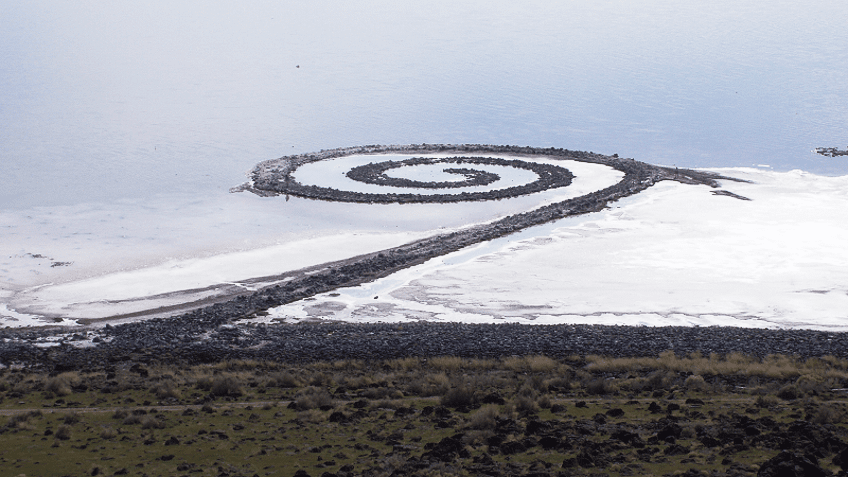
Smithson’s work on the jetty was considered an important contribution to land art due to its use of natural materials and consideration for the environment. The sculpture continues to be influenced by the water levels of the Great Salt Lake of Utah today.
Balloon Dog (1994 – 2000) by Jeff Koons
| Artist Name | Jeff Lynn Koons (1955 – Present) |
| Date | 1994 – 2000 |
| Medium | Stainless steel and transparent coating |
| Dimensions (cm) | 307.3 x 363.2 x 114.3 |
| Where It Is Housed | The Broad Museum, Los Angeles |
| Estimated Worth | $58.4 million |
Known as one of the most famous contemporary artists of the 20th century, Jeff Koons’ Balloon Dogs are one of the most easily recognized sculptures in the world. These unique balloons of steel are ironic and super popular for their incredible size and visual quality. Koons created a total of five large balloon dogs, executed in magenta, yellow, blue, orange, and red.
Each balloon dog in the series is crafted with genius, mirror polished, and finished with a colorful transparent coating.
Koons’ orange balloon dog was sold at auction by Christie’s for over its estimate, amounting to a whopping $58.4 million and a few years later, Koons topped his record by selling his steel rabbit for a massive $91.1 million. According to Koons, he “always enjoyed balloon animals because they’re like us. We’re balloons. You take a breath and you inhale, it’s optimism. You exhale, and it’s kind of a symbol of death.”
Maman (1999) by Louise Bourgeois
| Artist Name | Louise Joséphine Bourgeois (1911 – 2010) |
| Date | 1999 |
| Medium | Bronze, stainless steel, marble |
| Dimensions (cm) | 927.1 x 891.5 x 1023.6 |
| Where It Is Housed | National Gallery of Canada, Ottawa |
Maman, meaning mother in French, is a large stainless-steel sculpture depicting a spider with a sac enclosing 32 marble eggs with a ribbed bronze abdomen and thorax. Sculpted by the French-American artist, Louise Bourgeois as part of her commissioned Unilever Series in 2000, this giant arachnid alludes to the strong character of the artist’s mother and points to metaphors associated with the weaving, spinning, and protection. The artist lost her mother in her early twenties and attempted to commit suicide shortly after her mother’s death from an unidentified illness.
Often associated with evil and conniving actions, the spider was reimagined by Bourgeois as a metaphor that reminds her of her best friend, her mother, the figure of nature, and of a mother’s instinct of protection and nurture.

Cloud Gate (2006) by Anish Kapoor
| Artist Name | Anish Kapoor (1954 – Present) |
| Date | 2006 |
| Medium | Stainless steel |
| Dimensions (m) | 10 x 13 x 20 |
| Where It Is Housed | Millennium Park, Chicago, Illinois |
Inspired by liquid mercury, this massive shiny drop of steel can be found at the Millennium Park in Chicago and is one of the most famous sculptures in the world. The sculpture emerged after British-Indian artist, Anish Kapoor won a design competition and the sculpture was then erected in 2006.
The reflective nature of the sculpture distorts and mirrors the skyline and surrounding landscape.
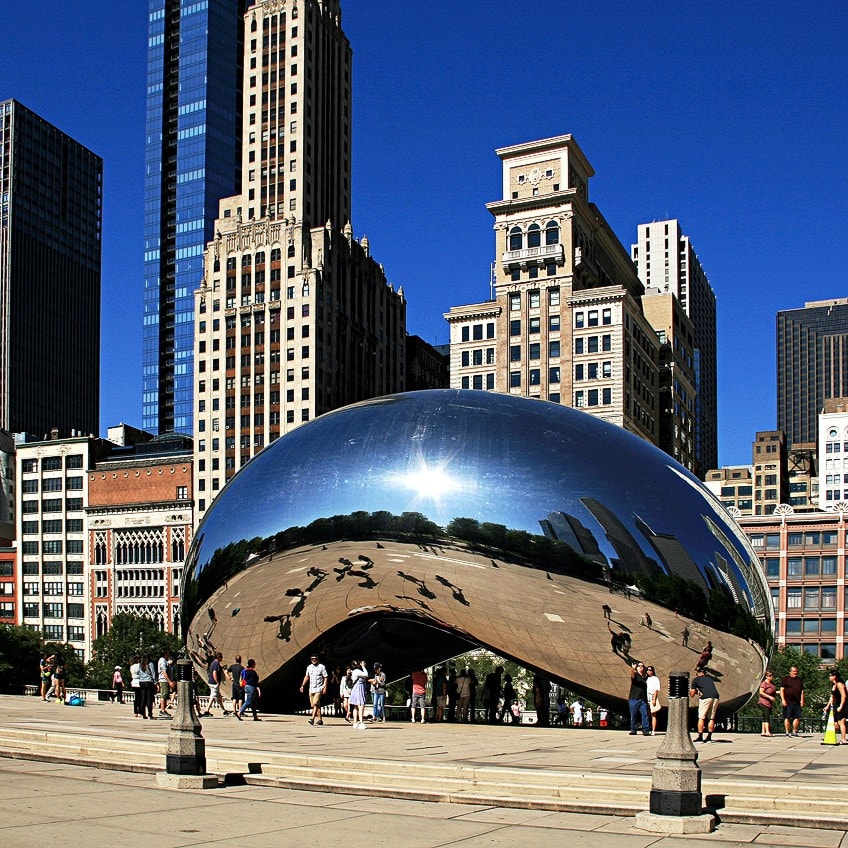
This immersive sculpture also allows people to walk underneath it so the experience of a sculpture is amplified. Extremely popular with Chicago’s tourists, this sculpture has also reached international recognition, receiving the nickname “the bean”, owing to the sculpture’s shape.
The World’s Most Famous Sculptors
Some of the most innovative minds such as Michelangelo, Donatello, and Gian Lorenzo Bernini have left their mark on art history through the technical display of genius in sculpture and rendition of classical and ancient subject matter. Below, you will find a few additional sculptors who have also achieved great success in the history of art.
Praxiteles of Athens (395 – 330 BC)
Praxiteles is perhaps one of the lesser well-known names that circulate across the history of sculpture. One of his famous works of the fourth century is Aphrodite of Knidos, which unfortunately did not survive the course of history. What remains for our reference are the Roman copies of his work, executed in marble. Aphrodite of Knidos is known as the first full-scale sculpture of a female nude, which became the primary point of reference for many other artists to follow.

Antonio Canova (1757 – 1822)
As a pioneer for neoclassical sculpture, Antonio Canova started his venture into sculpture at an early age and was regarded as one of Europe’s best sculptors since the appearance of Gian Lorenzo Bernini. Fueled by the nature of classical antiquity, Canova created many famous pieces such as Psyche Revived by Cupid’s Kiss (1793), which is currently housed at the Louvre in Paris.
Other famous works include The Three Graces (1814 – 1817) and Theseus and the Minotaur (1781 – 1782).
Constantin Brâncuși (1876 – 1957)
Also known as a champion of Modernism, Romanian sculptor Constantin Brâncuși drew his inspiration from European culture and Romanian folk traditions. Brâncuși’s sculptures are characterized by stark geometric lines and their “clean” aesthetic, as seen in his Bird in Space series.
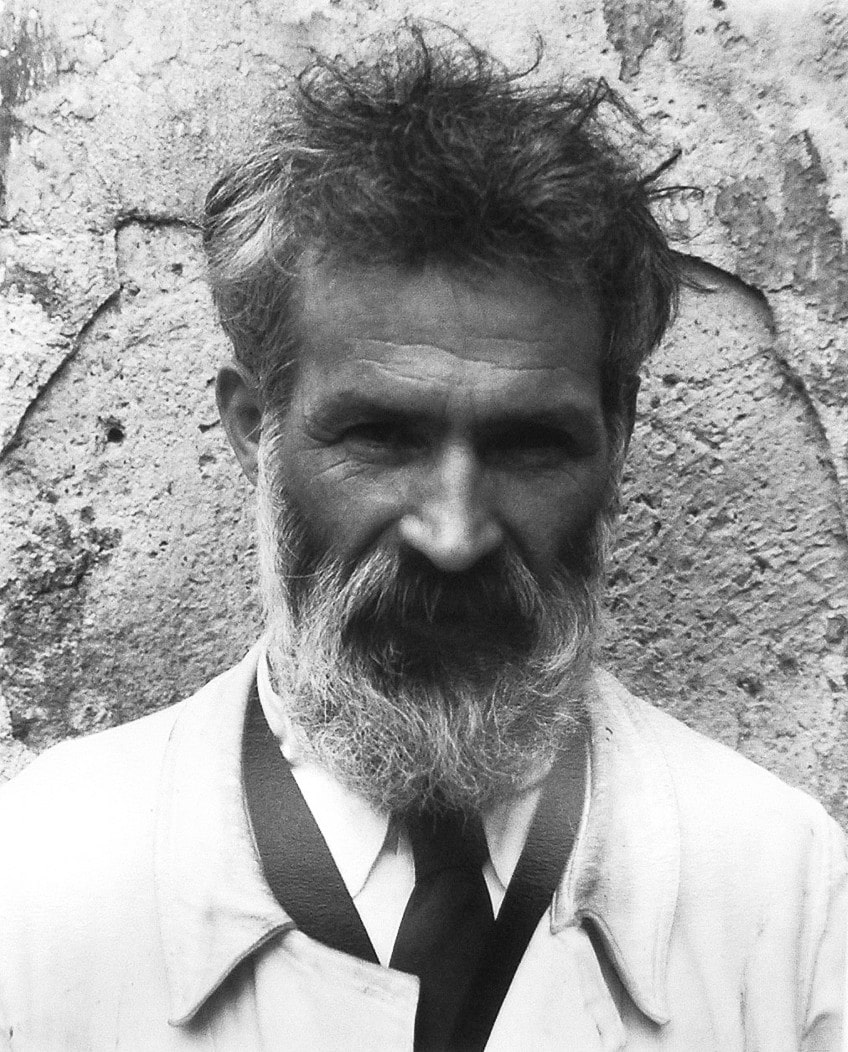
Henry Spencer Moore (1898 – 1986)
Henry Moore is an English sculptor famous for his influence on public art sculptures in post-World War II Britain. Moore often portrays themes of the mother and child while making use of reclining figures. Although semi-abstract, his works enable viewers to fully observe his sculptures through clean-cut lines.
You can find the largest collection of Henry Moore artworks at his estate in Perry Green in Hertfordshire.
Alberto Giacometti (1909 – 1966)
Swiss artist Alberto Giacometti was born into art with his father being Giovanni Giacometti, an Impressionist painter. Like many creatives, Giacometti moved to Paris where his artistic career began and soon found himself in the company of the Surrealists. Giacometti thereafter took a turn towards the Existentialist style and produced some of his most famous pieces such as Man Walking (1960), which sold for $104.3 million in 2010. Other famous sculptures by this artist include Gazing Head (1929), The Chariot (1950), and Femme debout (1956).

Sculpture: A Site of Transformation and Meaning
As you may observe from some of the world’s most famous sculptures listed above, sculpture as an art form and medium is dynamic and highly transformative. Over centuries, one can observe the changes and developments of sculpture and how artists have adapted the meaning of the medium and art form through material and construction.
As noted in the introductory paragraphs of this article, sculpture was heavily reliant upon material and mastery over the manipulation of materials such as bronze, marble, and other durable materials.
The development of sculpture as an art practice moves away from just the simple use of seemingly “difficult” mediums to include more complex thoughts around process, dimensionality, texture, and meaning. Sculpture as a site for transformation and meaning-making is further amplified by the artist’s intention behind “revolutionary” pieces such as Donatello’s bronze David and even Marcel Duchamp’s Fountain (1917; replica 1964), which both employ sculpture to challenge previous notions and ideal associated with the medium.

Ways in which sculpture has transformed evolved from the basic representation of daily human life involving decorative elements, mythological characters, and the human body to more complex ideas around what a sculpture can be, how sculpture can evoke ambiguity, and how sculpture could enhance or impact the experience of the viewer. The progression of sculpture, therefore, revolves around the social, political, economic, and historical events of each piece.
Alongside each famous sculpture by their equally famous makers revolved around the happenings of the time, including the preferences of their respective audiences and the artist’s will to challenge that which came before.
Unlike painting or photography, sculpture can be realized on a much larger scale and penetrates “the real world”. Artworks such as Anish Kapoor’s Cloud Gate not only immerse the viewer into the sculpture, but they also add another dimension by distorting the reflections of the real world. The evolution of sculpture becomes more symbolic and complex, even if it is made up of simple materials, as seen in Alexander Calder’s circus sculpture. The additional level of performativity added to Calder’s Circus extends the experience of the viewer and takes the idea of the spectator to a new level.
The world’s most famous sculptures as discussed above are famous for their influence on art history and their impact on sculpture as a practice. Sculpture offers artists variety and room for experimentation, which gives rise to some of the greatest sculptural masterpieces of art history. Other famous sculptures include The Terracotta Army (210 – 209 BC), Laocoön and His Sons (2nd century BC) by Agesander of Rhodes, Athanadoros, Polydoros, Athenodoros of Rhodes, Polydorus of Rhodes, and Ecstasy of Saint Teresa (1647 – 1652) by Gian Lorenzo Bernini.
Take a look at our famous statues webstory here!
Frequently Asked Questions
What Is the Oldest Figure Sculpture in the World?
The oldest statuettes include the Venus of Hohle Fels and the Löwenmensch figurine, which are approximately 35 to 40 thousand years old.
What Is the Most Famous Sculpture in the World?
On the top of many lists, the Venus of Willendorf is considered to be the most popular sculpture in the world, dating back 25 to 30 thousand years ago.
What Are the Different Types of Sculpture?
The different types of sculpture in art include relief sculpture, three-dimensional sculpture, carved sculptures, cast sculptures, additive sculptures, assembled sculptures, subtractive sculptures, installation sculptures, kinetic sculptures, modeled sculptures, and earthwork sculptures.
How Is a Sculpture Made?
A sculpture can be constructed by applying different sculpture techniques and using mediums such as clay, wood, metals, and any other material that allows you to create any of the different types of sculptures, often with a three-dimensional element. You can either carve, cast, model, or assemble a sculpture.
Who Is the Most Famous Sculptor?
The most famous sculptor is considered to be Michelangelo Buonarroti, who is also referred to as the so-called divine one.
Is a Sculpture the Same as a Statue?
A statue is considered to be a type of sculpture; therefore, all statues are called sculptures, however, the same cannot be said for sculptures since the subject represented in a statue can only be a human, deity, or animal.
Jordan Anthony is a Cape Town-based film photographer, curator, and arts writer. She holds a Bachelor of Art in Fine Arts from the University of the Witwatersrand, Johannesburg, where she explored themes like healing, identity, dreams, and intuitive creation in her Contemporary art practice. Jordan has collaborated with various local art institutions, including the KZNSA Gallery in Durban, the Turbine Art Fair, and the Wits Art Museum. Her photography focuses on abstract color manipulations, portraiture, candid shots, and urban landscapes. She’s intrigued by philosophy, memory, and esotericism, drawing inspiration from Surrealism, Fluxus, and ancient civilizations, as well as childhood influences and found objects. Jordan is working for artfilemagazine since 2022 and writes blog posts about art history and photography.
Learn more about Jordan Anthony and about us.
Cite this Article
Jordan, Anthony, “Famous Sculptures – Discover History’s Most Famous Art Statues.” artfilemagazine – Your Online Art Source. September 12, 2022. URL: https://artfilemagazine.com/famous-sculptures/
Anthony, J. (2022, 12 September). Famous Sculptures – Discover History’s Most Famous Art Statues. artfilemagazine – Your Online Art Source. https://artfilemagazine.com/famous-sculptures/
Anthony, Jordan. “Famous Sculptures – Discover History’s Most Famous Art Statues.” artfilemagazine – Your Online Art Source, September 12, 2022. https://artfilemagazine.com/famous-sculptures/.


